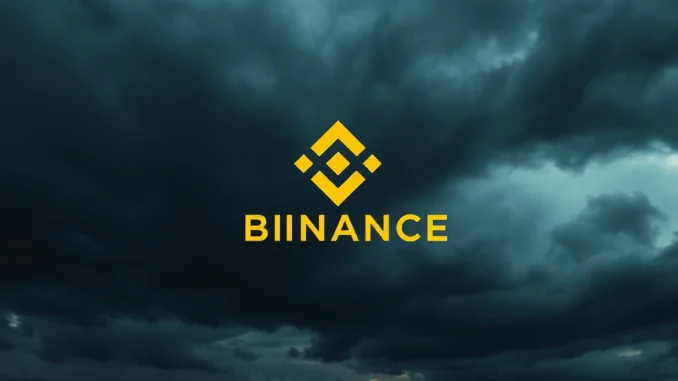
Heads up, crypto traders! Binance, the world’s leading cryptocurrency exchange, has just dropped a bombshell announcement. Get ready for a significant shift in the market as Binance is set to delist seven spot trading pairs. This is a crucial update for anyone involved in crypto trading, so let’s dive straight into what you need to know.
Breaking: Binance Announces Delisting of Multiple Spot Pairs
In an official announcement released on their website, Binance confirmed that it will be removing several spot pairs from its platform. The scheduled date for this delisting is April 11th, at precisely 03:00 UTC. Mark your calendars, because this change could impact your trading strategies and portfolio.
Here’s the list of crypto spot pairs facing the axe:
- ACT/BRL
- ALPHA/BTC
- BLUR/BTC
- CELR/BTC
- PENGU/BNB
- POND/BTC
- RUNE/BNB
If you are currently trading or holding any of these pairs, it’s time to pay close attention. But before you panic, let’s understand what this Binance delisting means and what actions you should consider.
Why is Binance Delisting These Spot Pairs?
While Binance’s announcement is direct about the *what* and *when*, it doesn’t explicitly state the *why*. However, delistings in the crypto world are not uncommon, and there are several typical reasons an exchange like Binance might choose to remove spot pairs. Let’s explore some of the potential factors:
- Low Trading Volume and Liquidity: This is often the primary culprit. If a trading pair consistently shows low trading volume and limited liquidity, it becomes less attractive for an exchange to maintain. Low liquidity can lead to wider bid-ask spreads, making trading less efficient and potentially riskier for users. Exchanges want to offer pairs that are actively traded to ensure a healthy market environment.
- Project Development and Viability: Sometimes, the underlying projects associated with these tokens might face challenges. This could include a lack of ongoing development, decreased community interest, or even regulatory issues. If Binance assesses that a project’s long-term viability is questionable, delisting the spot pair can be a proactive measure.
- Compliance and Regulatory Scrutiny: The regulatory landscape for cryptocurrencies is constantly evolving. Binance, as a global crypto exchange, must navigate a complex web of regulations. Delisting certain pairs could be a preemptive move to ensure compliance with various jurisdictions and avoid potential regulatory hurdles. Specific tokens might come under increased scrutiny, prompting exchanges to remove them as a precautionary step.
- Maintaining Platform Quality: Binance aims to offer a high-quality trading experience. This includes regularly reviewing listed pairs and removing those that no longer meet their standards. Delisting underperforming or less popular pairs helps streamline the platform and focus resources on more active and robust markets.
It’s likely a combination of these factors that leads to a Binance delisting decision. While the exact reasons for these specific seven pairs aren’t detailed, these are generally the main considerations for any exchange.
Impact on Traders: What Happens Next?
If you are currently trading or holding any of the affected spot pairs, you might be wondering what steps you need to take. Here’s a breakdown of the key implications and actions:
- Trading Ceases on April 11th: The most immediate impact is that trading for these pairs will stop on April 11th at 03:00 UTC. After this time, you will no longer be able to place new buy or sell orders for ACT/BRL, ALPHA/BTC, BLUR/BTC, CELR/BTC, PENGU/BNB, POND/BTC, and RUNE/BNB spot pairs on Binance.
- Withdrawal of Assets: Even after delisting, Binance typically continues to support withdrawals of the base and quote assets (e.g., ACT, BRL, ALPHA, BTC, etc.). You will likely still be able to withdraw your tokens from Binance to an external wallet. However, it’s always wise to withdraw your assets promptly to avoid any potential future complications, although Binance usually provides ample time for withdrawals. Keep an eye on official announcements for specific withdrawal timelines.
- Alternative Trading Options: If you still wish to trade these tokens, you will need to explore other crypto exchanges that might list these pairs. It’s important to research and choose reputable platforms if you decide to move your trading activity elsewhere.
- Portfolio Rebalancing: This Binance delisting event is a good opportunity to review and rebalance your portfolio. Consider whether you want to continue holding the affected tokens or if you want to liquidate your positions before the delisting date (while trading is still available).
- Market Volatility: Delisting announcements can sometimes lead to increased volatility in the price of the affected tokens. Traders might react to the news by selling off their holdings, potentially causing price drops. Be prepared for potential price fluctuations in the short term.
Actionable Insights for Crypto Traders
So, what should you do if you are affected by this Binance delisting? Here are some actionable insights:
- Check Your Portfolio: First and foremost, identify if you hold any of the delisted spot pairs. Review your Binance account and see if you have any holdings in ACT/BRL, ALPHA/BTC, BLUR/BTC, CELR/BTC, PENGU/BNB, POND/BTC, or RUNE/BNB.
- Decide on Your Strategy: Determine your plan of action. Do you want to sell your holdings before April 11th? Do you want to withdraw the tokens and hold them long-term? Or do you want to seek out alternative exchanges to continue trading these pairs?
- Execute Your Plan Promptly: If you decide to sell or withdraw, don’t wait until the last minute. Exchange platforms can experience higher traffic volumes around delisting events, so acting sooner rather than later is advisable.
- Stay Informed: Keep monitoring Binance’s official announcements and social media channels for any further updates regarding the delisting process and withdrawal timelines.
- Diversify Your Holdings: This event underscores the importance of diversification in crypto trading. Relying too heavily on a small number of assets can expose you to risks like delisting. A well-diversified portfolio can help mitigate such risks.
Broader Market Implications of Altcoin Delisting
While delisting specific spot pairs is a routine process for exchanges, it does have broader implications for the crypto market, particularly for altcoin delisting events. Here’s what we can infer:
- Market Maturation: Delistings are a sign of a maturing crypto market. Exchanges are becoming more discerning about the projects they support, focusing on quality, liquidity, and compliance. This is a positive trend overall, as it helps to weed out less viable projects and promotes a healthier ecosystem.
- Increased Scrutiny on Altcoins: Altcoin delisting events can put pressure on other similar projects. Traders may become more cautious about investing in smaller or less established altcoins, knowing that they could face similar risks of delisting if they don’t maintain sufficient trading volume and project viability.
- Opportunity for Consolidation: Delistings can lead to consolidation within the crypto space. As some projects fade, others with stronger fundamentals and community support may attract more attention and investment.
- Focus on Due Diligence: For traders and investors, these events highlight the critical need for thorough due diligence. Don’t just chase hype; research the projects you invest in, understand their tokenomics, development activity, and community support, and be aware of the risks involved, including the possibility of altcoin delisting.
In Conclusion: Navigating the Binance Delisting and Staying Ahead
The upcoming Binance delisting of seven spot pairs is a significant event that demands attention from crypto trading enthusiasts and holders of the affected tokens. While delistings can seem concerning, they are a normal part of the crypto market’s evolution. By understanding the implications, taking proactive steps, and staying informed, you can navigate these changes effectively. Remember to always prioritize risk management, diversify your portfolio, and conduct thorough research in the dynamic world of cryptocurrency. This urgent situation is a reminder to remain vigilant and adaptable in the ever-changing crypto landscape.



